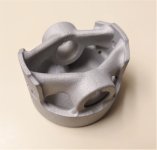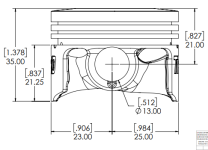Hi Novaguy:
IMO there are some basic things you must determine about your piston to get an idea of what your order of operations needs to be.
I assume the wrist pin needs to be centered on the axis of the piston and must also be perpendicular to it in the plane of rotation.
In your opinion, how good does it need to be in order to be successful?
Do you need to get it perpendicular within a thou?
Within a tenth?
Within 10 thou?
How accurately must it intersect the axis of the piston?
Which is the more important consideration?
Once you are satisfied you know that (or have a reasonable guess) you can start to decide how to tackle it.
Two ways forward:
1) Machine the piston body first and locate the wrist pin bore to suit the body.
2) Ream the wrist pin bore first and align the turning operation for the body to the position of the bore you've made.
Either way will work if you spend enough effort on it but which you choose will determine how much fucking around you will have to accept.
A machine shop will almost always choose to turn the body first in order to have datums to fixture to.
They will then single point bore the wrist pin bores for location and then finish them to size, either by boring them or reaming them or honing them or whatever.
Easy for them to do because they have everything they need...you state that you do not.
The way you propose is concerning for two reasons:
a) it's difficult to get the wrist pin bores perpendicular to the plane of rotation of the wrist pin at the same time it intersects the piston axis while chucking it in the lathe.
b) you only have twenty thou per side to clean up the piston body...that may not be enough.
Additionally, reaming non round holes without pre-boring them is going to be a pig's breakfast, especially if you hope to hand ream them.
Likely the finished holes won't be very round, and it'll be very hard to hold size, especially if you hand ream them with a hand reamer in a tap wrench and the piston in a vise.
It's almost certain you'll bellmouth the reamed hole.
So, your way potentially creates problems for you, most of which can be resolved by adopting Rob F's and Nmbmxer's strategy in posts #5 and #8.
If you can clamp the piston to the lathe carriage, you can single point line bore the wrist pin holes to get them round and on location.
You can ream them to size, and though they won't be as good as a factory piston, they'll be miles better than a hacker ream job.
Your challenge is to mount the piston securely and accurately onto the lathe cross slide.
Do you have a way to do that?
Ideally you could find a way to bolt a 3 jaw chuck on to the cross slide.
Finding a way to clamp the piston to the toolpost will also work.
If you do it this way, it pays to turn the piston OD first so you can indicate off the OD and the piston face.
It's a pity you didn't come to us BEFORE you had the print made...if you had, I would have recommended having a cylindrical shank printed right onto the face of the piston to allow you to turn everything in one shot and then just chop off the shank when you face the piston.
I also would have encouraged you to leave a lot more stock on the OD.
Once you have the piston turned, you can set it up on the cross slide, clock it in and go to town.
With care you'll get it as good as the typical machine shop will get it, and it'll likely work about as good as you expected it to work.
If you decide you're going to try to do it the other way, you will need a four jaw chuck for the lathe so you can move the blank around to dial it in.
Put soft aluminum or copper shims on the jaws so you can encourage it into perpendicularity with a rubber knocker and then squeeze it into coaxiality with the four jaw.
Expect to do this a whole bunch of times before both orientations are very good.
Turn as much of the piston as you can, then flip it, clock it in again with the 4 jaw, and turn the rest of it.
So yes, it's definitely doable, and with patience in your setups you can even make it pretty damned good.
Good enough to look back on your work with pride.
Cheers
Marcus
www.implant-mechanix.com
www.vancouverwireedm.com










